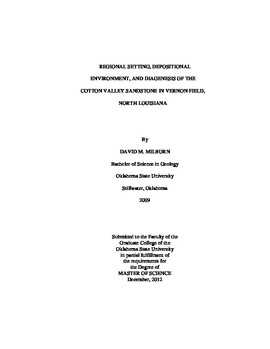| dc.contributor.advisor | Puckette, James | |
| dc.contributor.author | Milburn, David Michael | |
| dc.date.accessioned | 2014-03-14T21:52:02Z | |
| dc.date.available | 2014-03-14T21:52:02Z | |
| dc.date.issued | 2012-12-01 | |
| dc.identifier.uri | https://hdl.handle.net/11244/8038 | |
| dc.description.abstract | Eleven cores were examined from wells drilled in the CVG in Vernon Field, LA. These core data were integrated with regional studies and wireline log data to interpret the regional context of the field, depositional facies, prosity types, and diagenetic history. The Cotton Valley Group at Vernon field falls into a lagoonal region known as the "Hico Lagoon" during the Late Jurassic and Early Cretaceous which had low current and wave energy due to limited access to large oceans, surrounding topographic highs, and intermittent barrier islands. The Hico shale is the unit which the sands of the CVG pinch-out into up-dip. The depositional setting of the CVG sandstones is interpreted as a dynamic tidal flat ranging from mud flats, to mixed flats, to sand flats. The primary lines of evidence are oyster shells and hash accumulations, oyster and polychaete burrows, heterolithic laminae, and bidirectional flow features. Depositional facies include three main groups: (1) intertidal mudstones to siltstones, (2) subtidal sandstones, and (3) diagenetically modified heavily calcite cemented sandstones. Group one includes core Facies 1 (mudrocks), Facies 2 (matrix supported siltstones), and Facies 3 (grain supported siltstones) which form a continuum. Group 2 include Facies 4 which is generally darker colored and contains more biostrutures, and Facies 5 which is generally lighter colored, appears cleaner, and contains most of the flow features. Group 3 includes core Facies 6 which are calcite cemented sandstones with no porosity typically associated with zones of shells or fossil hash. Porosity is mostly secondary intragranular and moldic, and formed by partial to complete dissolution of grains by organic acids associated with the maturation of kerogen in the system. Observed primary porosity is minimal and appear to have been reduced by early calcite and quartz cement. Facies 4 is considered the best reservoir in the CVG sandstones of Vernon Field because it has the highest average porosity and permeability. Facies five is also important but has slightly lower porosity and permeability. Conventional wireline logs do not have the capability of resolving individual facies. | |
| dc.format | application/pdf | |
| dc.language | en_US | |
| dc.publisher | Oklahoma State University | |
| dc.rights | Copyright is held by the author who has granted the Oklahoma State University Library the non-exclusive right to share this material in its institutional repository. Contact Digital Library Services at lib-dls@okstate.edu or 405-744-9161 for the permission policy on the use, reproduction or distribution of this material. | |
| dc.title | Regional Setting, Depositional Environment, and Diagenesis of the Cotton Valley Sandstone in Vernon Field, North Louisiana | |
| dc.type | text | |
| dc.contributor.committeeMember | Cruse, Anna | |
| dc.contributor.committeeMember | Boardman, Darwin | |
| osu.filename | Milburn_okstate_0664M_12420.pdf | |
| osu.college | Arts and Sciences | |
| osu.accesstype | Open Access | |
| dc.description.department | Boone Pickens School of Geology | |
| dc.type.genre | Thesis | |
| dc.subject.keywords | core | |
| dc.subject.keywords | cotton valley | |
| dc.subject.keywords | north louisiana | |
| dc.subject.keywords | sedimentology | |
| dc.subject.keywords | tidal flat | |
| dc.subject.keywords | vernon field | |
